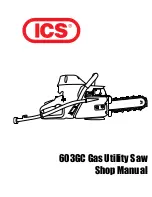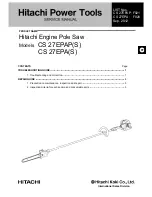
16
8. Tighten the tension on the blade by
turning the blade tension knob (2)
clockwise. If the tension is too tight, turn
counterclockwise. If too loose, turn the
knob clockwise. Do not make too tight or
blade will easily break in use. (Fig. E)
BEVEL ADJUSTMENT (FIG. K, L)
1. Remove the blade guard foot (1) by using
the Phillips screwdriver to loosen the
screw (2). (Fig. K)
Fig. K
2. Loosen the table lock knob (3) and move
the table (4) until it is approximately at a
right angle to the blade (5). (Fig. L)
3. Loosen the lock nut (6) and adjust the
adjusting screw (7) under the table by
turning counterclockwise.
4. Lower the adjusting screw (7) by turning
clockwise.
5. Use a combination square (8) to set the
table exactly 90° (0°) to the blade. If there
is space between the square and blade,
adjust the table angle until the space is
closed.
6. Lock the table lock knob (3) to prevent
movement. Raise the adjusting screw (7)
under the tabel until the tip of the screw
touches the table.
7. Tighten the lock nut (6).
8. When the blade is exactly 90° (0°) to the
table, loosen the bevel indicator screw (9)
using a Phillips screwdriver.
9. Adjust the bevel indicator (10) to the “0”
mark on the bevel scale and retighten the
indicator screw (9).
10. Attach the blade guard foot (1) using the
Phillips screwdriver, so the foot rests flat
against the table and tighten.
Fig. L
BLADE GUARD FOOT ADJUSTMENT
(FIG. M)
NOTE:
User must keep constant downward
pressure on workpiece when cutting. The
blade guard foot is not designed to hold down
the workpiece, but is rather to help prevent
the workpiece from lifting up excessively.
When cutting at angles, the blade guard
foot (1) should be adjusted so it is parallel to
the table and rests flat above the workpiece.
1. To adjust, loosen the screw (2) with the
Phillips screwdriver, tilt
the blade guard
foot (1) parallel to table, and tighten the
screw (2).
2. Loosen the
blade guard foot lock knob
(3)
to raise or lower the foot until it rests
slightly above the workpiece. Tighten
blade guard foot lock knob (3)
.
Fig. M
SAWDUST BLOWER (FIG. M)
The sawdust blower (4) should be positioned
to point to the blade and workpiece to blow
sawdust out of the line-of-sight when cutting.
It is not designed to blow all of the sawdust off
the table.
3
4
5
8
6
7
9
10
2
1
1
4
2
3
Содержание PCXB340SS
Страница 10: ...10 UNPACKING YOUR SCROLL SAW B A...













































